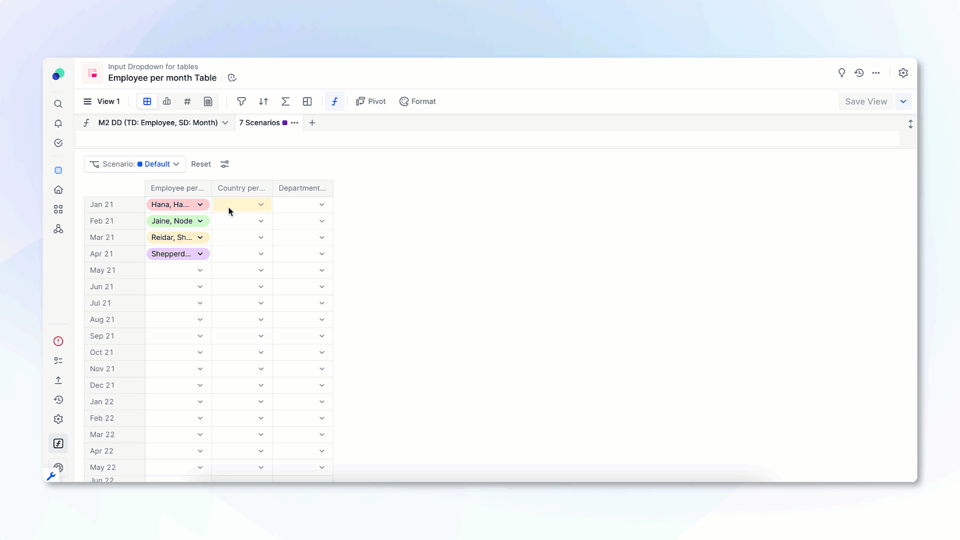When working with Table Views, you can create dependent dropdown menus to filter the available items in dropdown menus for Metrics. These can be filtered based on the cell coordinates, selected items in other Dimension Metrics within the same Table, or a combination of both. This filtering is configured at the Table level through rules that map Dimensions of the configuration Metric to Dimensions of the Metrics in the Table.
To perform this task, you need the Can Configure Block permission.
Let’s say you have two Metrics, one for Employees and one for Employee Departments, and these are both segmented by Month. Dependent dropdowns allow you to filter the available departments based on where the employee was located that month using a transaction list. This type of filtering is common in situations where the inputs are driven by time Dimensions, which are possible in Tables, but not in Lists.
Before you begin
Some points to consider when you create a dependent dropdown on a Table:
- At least one Metric in the Table must be of type Dimension. This serves as the basis for the dropdown.
- In the dependent dropdown configuration:
- You need to select at least one Metric.
- If you select more than one Metric, the selected Metrics need to share common structural Dimensions.
- You can select up to 5 Dimensions, however:
- each rule can link up to 5 different Dimensions together
- you can’t link the same structural Dimension twice in different rules - You cannot select the same Metric twice.
- If you have an existing configuration Metric:
- This must be a Boolean Metric.
- It must be structured on the Dimensions that are used as the type or format of the Metrics you select in the dependent dropdown configuration.
- If you select common structural Dimensions, these also need to be present in your existing configuration Metric.
- The dependent dropdown configuration applies to all Views of the Table.
That is, the Metric doesn’t need to be visible in the View, but it needs to be present in the Table. - After the configuration Metric is set up, you can use it for multiple different connections.
- Scenarios are taken into account in dependent dropdowns on Tables.
Dependent dropdowns on Tables filter suggested items based on the inputs within the Table, including the selected Scenario selected. Inputs in the configuration metric for the rule need to align with the scenarios to provide accurate suggestions.
Create a Dependent Dropdown on a Table
- Go to the Table where you need to set up a dependent dropdown.
This Table needs to contain Metrics of type Dimension. - Click the Settings icon.
- Click Dependent dropdowns, and then click Connect.
- From the menu, select the Metrics you want to connect.
You need to select at least one Metric. - (Optional) Select a common structural Dimension that connects your Metrics.
- Click Configure Connections.
- Do one of the following:
- Use an existing configuration Metric. If a matching Configuration Metric already exists, select it from the menu.
- Create a new configuration Metric. If no configuration Metric exists, you’re prompted to create a new one. We explain how to do this using the wizard below.
- (Optional) In the Dependent dropdown section of your Table settings, you can review, edit, and delete your dependent dropdown.
- (Optional) Open the new configuration Metric in Block Explorer to view the linked connections for each Property.
Create a New Configuration Metric
When you create a new configuration Metric, the configuration wizard opens a Metric in Boolean format. It also displays the Dimensions used in your selected Properties in rows or columns, and pages.
To set up the new configuration Metric:
- Click Configure Connections.
- In the wizard, do one of the following:
- Write a formula in the Formula field.
- Select the checkboxes to specify the linked connections that you need. - Click Save Configuration.
- Enter a name for your new configuration Metric and click Save configuration.

Editing Dropdown Connections
After a connection is established, you can continue to fill or adjust the data in the Metrics that were used to configure the connection. It will not affect any inputs that were used in the dropdowns.
However, if the configuration Metric Dimensions are adjusted or if the data type changes, this will break the connection.



